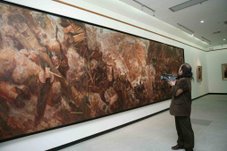
[T]he painters climbed freehand, with no safety equipment in sight, spreading out on the wires as though they were circus performers, or the notes of a jazz riff playing above the skyline.
Sometimes real art isn't recognized for what it is until a new generation experiences it with new eyes. Last week's issue of The New Yorker magazine carried a remarkable photo by an unknown photographer of the first third of the Twentieth Century -- Eugene de Salignac.
You haven't heard of him. Hardly anyone has. He may not have heard of himself -- at least not as an artist.
But surely he applied to his work a lively artistic imagination, took as much care, and put into the visual outcome as much effort as any artist. The photo we speak of, reproduced above, was accompanied by a short sidebar written by his great granddaughter, Michelle Preston:
All of this, his decendants learned when --
You haven't heard of him. Hardly anyone has. He may not have heard of himself -- at least not as an artist.
But surely he applied to his work a lively artistic imagination, took as much care, and put into the visual outcome as much effort as any artist. The photo we speak of, reproduced above, was accompanied by a short sidebar written by his great granddaughter, Michelle Preston:
"No one in my family remembered much about my great-grandfather de Salignac. He was divorced from my great-grandmother soon after 1900, and lived the rest of his life alone, in New York City. My mother had a vague idea that he was a stockbroker; as a child, I never even saw a picture of him."It turns out de Salignac wasn't a stockbroker; he had a job working for the City of New York photographing new construction sites from 1903 to 1934. It was a period, as Ms. Preston says, when "vast reaches of infrastructure were laid down" in the bustling, reborn metropolis.
All of this, his decendants learned when --
"[A] few years ago we received a call from... Michael Lorenzini, of the Municipal Archives of the City of New York. He had been examining a large collection of images—nearly twenty thousand glass negatives and a hundred and thirteen scrapbooks of prints — when he realized that they had all been shot by a single unknown photographer, Eugene de Salignac."
De Salignac's photographs are fascinating, even masterful. And surely they qualify as art, whatever he or his contemporaries may have asssumed.
Now, the best of his photos have been assembled in a new book, “New York Rises” (Aperture Press), and rhe Museum of the City of New York opens an exhibit of de Salignac photographs on May 4.
Now, the best of his photos have been assembled in a new book, “New York Rises” (Aperture Press), and rhe Museum of the City of New York opens an exhibit of de Salignac photographs on May 4.

No comments:
Post a Comment